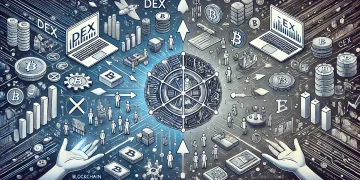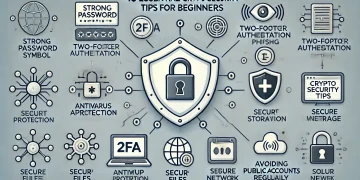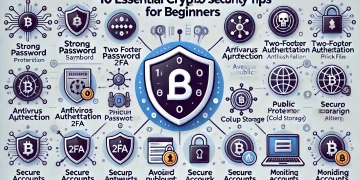In today’s rapidly evolving digital landscape, blockchain technology has emerged as a revolutionary force, promising to reshape industries and redefine how we conduct transactions, store data, and build trust in the digital realm. If you’re new to the concept of blockchain, you’re not alone. This comprehensive guide will walk you through the key concepts of blockchain technology, helping you understand its potential and implications for the future.
Table of Contents
- What is Blockchain?
- The History of Blockchain
- How Does Blockchain Work?
- Key Components of Blockchain
- Types of Blockchain Networks
- Blockchain Use Cases
- Advantages of Blockchain Technology
- Challenges and Limitations
- The Future of Blockchain
- Getting Started with Blockchain
What is Blockchain?
At its core, blockchain is a distributed digital ledger technology that allows for secure, transparent, and tamper-resistant record-keeping. Instead of relying on a central authority to manage and validate transactions, blockchain uses a network of computers (nodes) to collectively maintain and verify the integrity of the data.
The term “blockchain” comes from its structure: a chain of blocks, where each block contains a list of transactions or other data. These blocks are linked together using cryptography, creating an unbroken chain of information that can be traced back to the very first block, known as the genesis block.
The History of Blockchain
While blockchain technology gained widespread attention with the rise of Bitcoin in 2009, its roots can be traced back to earlier cryptographic and distributed systems research:
- 1991: Stuart Haber and W. Scott Stornetta introduce the concept of a cryptographically secured chain of blocks.
- 1998: Computer scientist Nick Szabo proposes “bit gold,” a decentralized digital currency system.
- 2008: An individual or group using the pseudonym Satoshi Nakamoto publishes the Bitcoin whitepaper, describing a peer-to-peer electronic cash system.
- 2009: The Bitcoin network goes live, marking the first practical implementation of blockchain technology.
- 2015: Ethereum launches, introducing smart contracts and expanding blockchain’s potential beyond cryptocurrencies.
Since then, blockchain technology has continued to evolve, with numerous projects and platforms emerging to address various use cases across industries.
How Does Blockchain Work?
To understand how blockchain works, let’s break down the process into steps:
- Transaction Initiation: A user initiates a transaction, such as sending cryptocurrency or updating a record.
- Block Creation: The transaction is bundled with other recent transactions into a block.
- Block Broadcast: The new block is broadcast to all nodes in the network.
- Validation: Nodes in the network verify the transactions in the block according to the network’s consensus rules.
- Consensus: The network reaches agreement on the validity of the block through a consensus mechanism (e.g., Proof of Work or Proof of Stake).
- Block Addition: Once consensus is reached, the new block is added to the existing chain of blocks.
- Transaction Completion: The transaction is now considered confirmed and becomes a permanent part of the blockchain.
This process ensures that all participants in the network have an identical copy of the ledger, creating a single source of truth without the need for a central authority.
Key Components of Blockchain
Several critical components work together to make blockchain technology function:
1. Nodes
Nodes are computers or devices that participate in the blockchain network. They store a copy of the blockchain, validate transactions, and help maintain the network’s integrity.
2. Blocks
Blocks are the basic units of the blockchain, containing a set of transactions or data. Each block includes:
- A timestamp
- A unique identifier (hash)
- The hash of the previous block (creating the “chain”)
- Transaction data
- Additional metadata
3. Cryptographic Hash Functions
Hash functions are mathematical algorithms that convert input data of any size into a fixed-size output (hash). In blockchain, they’re used to create unique identifiers for blocks and to link blocks together securely.
4. Consensus Mechanisms
Consensus mechanisms are protocols that ensure all nodes in the network agree on the validity of transactions and the order in which they’re added to the blockchain. Common consensus mechanisms include:
- Proof of Work (PoW)
- Proof of Stake (PoS)
- Delegated Proof of Stake (DPoS)
- Practical Byzantine Fault Tolerance (PBFT)
5. Smart Contracts
Smart contracts are self-executing contracts with the terms of the agreement directly written into code. They automatically execute when predefined conditions are met, enabling trustless and automated transactions.
Types of Blockchain Networks
Blockchain networks can be categorized into three main types:
1. Public Blockchains
Public blockchains, like Bitcoin and Ethereum, are open to anyone. They’re fully decentralized, with no single entity controlling the network. Public blockchains offer the highest level of security and censorship resistance but may have slower transaction speeds and higher costs due to their size and complexity.
2. Private Blockchains
Private blockchains are controlled by a single organization. They’re useful for enterprises that want to leverage blockchain technology while maintaining control over access and governance. Private blockchains offer faster transactions and lower costs but sacrifice some of the decentralization and transparency of public networks.
3. Consortium or Federated Blockchains
Consortium blockchains are governed by a group of organizations rather than a single entity. They combine elements of both public and private blockchains, offering a balance between transparency, speed, and control. These are often used in industry-specific applications where multiple stakeholders need to collaborate.
Blockchain Use Cases
Blockchain technology has potential applications across numerous industries:
1. Finance and Banking
- Cross-border payments
- Trade finance
- Know Your Customer (KYC) and Anti-Money Laundering (AML) processes
- Asset tokenization
2. Supply Chain Management
- Product traceability
- Inventory management
- Counterfeit prevention
- Streamlined logistics
3. Healthcare
- Secure sharing of medical records
- Drug traceability
- Clinical trial management
- Health insurance claims processing
4. Government and Public Sector
- Voting systems
- Identity management
- Land registry
- Tax collection and management
5. Energy Sector
- Peer-to-peer energy trading
- Renewable energy certificates
- Grid management
- Electric vehicle charging networks
6. Real Estate
- Property records and titles
- Fractional ownership
- Rental agreements and payments
- Property management
7. Education
- Credential verification
- Lifelong learning records
- Copyright and licensing of educational content
- Student record management
Advantages of Blockchain Technology
Blockchain offers several key advantages over traditional centralized systems:
1. Decentralization
By distributing data across a network of nodes, blockchain eliminates single points of failure and reduces the risk of data loss or manipulation.
2. Transparency
All transactions on a public blockchain are visible to all participants, creating an auditable and transparent system.
3. Immutability
Once data is recorded on the blockchain, it becomes extremely difficult to alter or delete, ensuring the integrity of historical records.
4. Security
Cryptographic techniques and the distributed nature of blockchain make it highly resistant to hacking and fraud.
5. Efficiency
Blockchain can streamline processes by removing intermediaries and automating transactions through smart contracts.
6. Cost Reduction
By eliminating the need for third-party verification and reducing administrative overhead, blockchain can significantly lower transaction costs.
Challenges and Limitations
Despite its potential, blockchain technology faces several challenges:
1. Scalability
Many blockchain networks struggle to handle a high volume of transactions quickly and efficiently.
2. Energy Consumption
Proof of Work consensus mechanisms, used by Bitcoin and some other cryptocurrencies, require significant computational power and energy.
3. Interoperability
Different blockchain networks often can’t communicate with each other easily, limiting their potential for widespread adoption.
4. Regulatory Uncertainty
The legal and regulatory framework for blockchain and cryptocurrencies is still evolving in many jurisdictions.
5. User Experience
Blockchain applications can be complex and unintuitive for non-technical users, hindering mainstream adoption.
6. Privacy Concerns
While blockchain offers pseudonymity, the public nature of many blockchains can raise privacy concerns for certain applications.
The Future of Blockchain
As blockchain technology continues to mature, we can expect to see:
- Increased Adoption: More industries and governments exploring blockchain solutions for various use cases.
- Improved Scalability: Development of layer-2 solutions and more efficient consensus mechanisms to handle higher transaction volumes.
- Enhanced Interoperability: Creation of standards and protocols to enable different blockchain networks to communicate and share data.
- Integration with Other Technologies: Combination of blockchain with AI, IoT, and other emerging technologies to create powerful new applications.
- Regulatory Clarity: Establishment of clearer legal frameworks for blockchain and cryptocurrency use across jurisdictions.
- User-Friendly Interfaces: Development of more intuitive and accessible blockchain applications to drive mainstream adoption.
Getting Started with Blockchain
If you’re interested in exploring blockchain technology further, here are some steps you can take:
- Learn the Basics: Start with online courses, tutorials, and books to build a strong foundation in blockchain concepts.
- Explore Cryptocurrencies: Create a wallet and experiment with small amounts of cryptocurrency to understand how blockchain works in practice.
- Join Blockchain Communities: Participate in online forums, attend meetups, and engage with blockchain enthusiasts to stay up-to-date on the latest developments.
- Experiment with Development: If you’re technically inclined, try building simple blockchain applications or smart contracts using platforms like Ethereum or Hyperledger.
- Stay Informed: Follow reputable blockchain news sources and research publications to keep abreast of industry trends and breakthroughs.
- Consider Professional Development: Look into blockchain certifications or specialized courses to enhance your skills and credibility in the field.
By understanding the key concepts of blockchain technology, you’ll be better equipped to navigate the exciting and rapidly evolving world of decentralized systems. Whether you’re a business leader, developer, or simply a curious individual, blockchain has the potential to impact various aspects of our digital lives in the coming years.






























